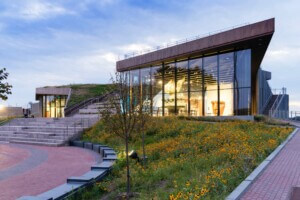For Ingalill Wahlroos-Ritter, associate dean at Woodbury University School of Architecture, director of WUHO Gallery, and co-founder of [WROAD], architectural practice and education are inextricably intertwined.
Wahlroos-Ritter, who joins moderator Alexander Korter (CO Architects) and co-presenters Michael Fox (Cal Poly Pomona), Quinyun Ma (USC), and Neil Denari (UCLA) in a panel on “Facade Education: Preparing Future Practitioners for True Performance” at next month’s Facades+ LA conference, first taught at Cornell University after her work as project architect on the Corning Museum of Glass attracted the school’s attention. That initial seminar, on the innovative use of glass in building envelopes, helped her carve out a professional niche in the field and also led to an appointment at Yale.
At the time, recalled Wahlroos-Ritter, Yale did not offer courses like hers—neither classes on glass, specifically, nor on the intersection of architecture and engineering more generally. “That has changed a lot, [especially] when I think back on when I went to school,” she said. The contemporary accreditation process, for one thing, “has elevated the need for systems integration,” explained Wahlroos-Ritter. While in the past it had not been unusual for students and faculty from other disciplines to consult on student work, she said, “to rely on engineers to complete a project is new.”
Her students’ relationship to technology like the performance simulation platform Autodesk Ecotect Analysis has also evolved since Wahlroos-Ritter began teaching. “Students are conversant with Ecotect as part of learning BIM,” said Wahlroos-Ritter. “That’s something I’m seeing more and more in curricula.” Meanwhile, students gain hands-on experience in fabrication by building mock-ups of building envelope components. “I think in some ways the academy is leading that part of the conversation,” said Wahlroos-Ritter. “Students are learning tools that aren’t necessarily part of the trade. Many senior architects don’t have the skills these students do.”
Wahlroos-Ritter relishes her job molding young minds. “For me, one of the exciting moments is the epiphany where students begin to see systems as an intrinsic part of design” rather than something to consider as a postscript, she said. “I talk about Louis Sullivan a lot. He considered the building a living, breathing organism—then everybody forgot about it, of course. I think there’s a renewed appreciation for the role building systems can have in the perceptual narrative of a building.”
Catch up with Wahlroos-Ritter and other facade educators, designers, fabricators, builders, and researchers at Facades+ LA January 28–29. Register today on the conference website.










